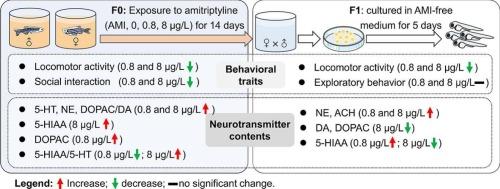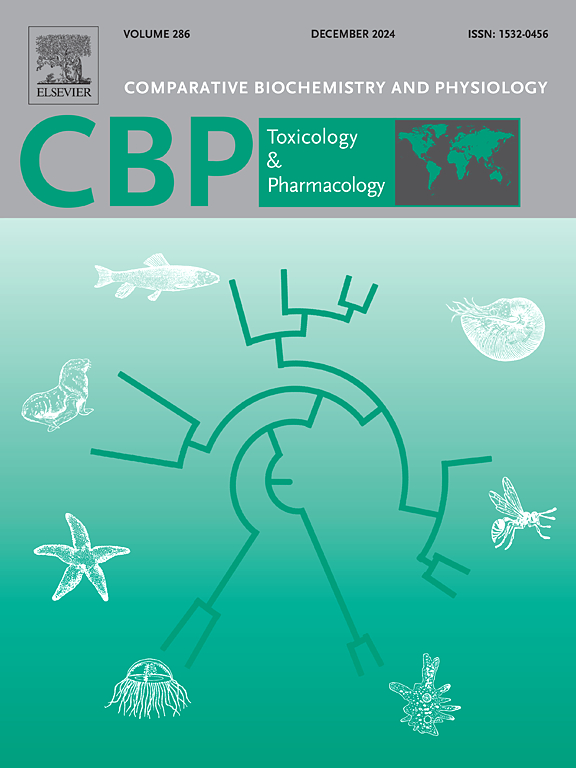暴露于阿米替林会通过改变神经递质水平干扰成年斑马鱼及其后代的行为。
IF 3.9
3区 环境科学与生态学
Q2 BIOCHEMISTRY & MOLECULAR BIOLOGY
Comparative Biochemistry and Physiology C-toxicology & Pharmacology
Pub Date : 2024-11-15
DOI:10.1016/j.cbpc.2024.110079
引用次数: 0
摘要
阿米替林(AMI)是广泛使用的三环类抗抑郁药(TCAs)之一,已成为水生生态系统中经常检测到的药物污染物。然而,AMI 暴露对鱼类的影响及其潜在机制仍然有限。在本研究中,成年斑马鱼(F0)分别暴露于 0(对照组)、0.8 和 8 μg/L 的 AMI 14 天。随后,暴露的斑马鱼配对产卵,它们的后代(F1)在不含 AMI 的培养基中饲养至受精后 5 天(dpf)。本研究旨在评估 F0 代(14 天暴露结束时)和 F1 代(5 dpf 时)的行为和神经递质水平的变化。结果表明,水中AMI暴露显著降低了F0斑马鱼的运动活性、身体接触频率和追逐持续时间,并导致其大脑中单胺神经递质水平发生明显变化。亲本暴露于 AMI 会显著提高 F1 斑马鱼的心率和眼球运动,但会降低其运动活动,同时单胺类神经递质和乙酰胆碱也会发生显著变化。此外,在 F0 代和 F1 代中,行为特征的变化与神经递质水平之间存在明显的相关性。我们的研究结果证实了单胺调节在 AMI 对斑马鱼及其后代神经行为毒性中的关键作用,并强调了关注 AMI 对鱼类多代影响的重要性。本文章由计算机程序翻译,如有差异,请以英文原文为准。

Exposure to amitriptyline disturbs behaviors in adult zebrafish and their offspring via altering neurotransmitter levels
Amitriptyline (AMI), one of the widely used tricyclic antidepressants (TCAs), has become a pharmaceutical contaminant frequently detected in aquatic ecosystems. However, the impacts of AMI exposure and underlying mechanisms on fish are still limited. In this study, adult zebrafish (F0) were exposed to AMI at 0 (control), 0.8, and 8 μg/L for 14 days. Subsequently, the exposed zebrafish were paired for spawning, and their offspring (F1) were reared in an AMI-free medium until 5 days post-fertilization (dpf). This study aimed to assess variations in behaviors and neurotransmitter levels in both the F0 (at the end of the 14-day exposure) and F1 generations (at 5 dpf). As a result, waterborne AMI exposure significantly reduced the locomotor activity, frequency of body contact, and duration of chase in F0 zebrafish, and resulted in notable changes in monoamine neurotransmitter levels in their brains. Parental exposure to AMI significantly elevated the heart rate and eye movement but reduced the locomotor activity in the F1 zebrafish, also along with significant changes in monoamine neurotransmitters and acetylcholine. Furthermore, significant correlations between the changes in behavioral traits and neurotransmitter levels were identified in both F0 and F1 generations. Our findings confirm the critical role of monoamine modulation in the neurobehavioral toxicity of AMI on zebrafish and their offspring, and emphasize the importance of paying attention to its multigenerational effects on fish.
求助全文
通过发布文献求助,成功后即可免费获取论文全文。
去求助
来源期刊
CiteScore
7.50
自引率
5.10%
发文量
206
审稿时长
30 days
期刊介绍:
Part C: Toxicology and Pharmacology. This journal is concerned with chemical and drug action at different levels of organization, biotransformation of xenobiotics, mechanisms of toxicity, including reactive oxygen species and carcinogenesis, endocrine disruptors, natural products chemistry, and signal transduction with a molecular approach to these fields.

 求助内容:
求助内容: 应助结果提醒方式:
应助结果提醒方式:


